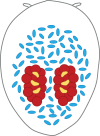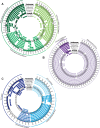Partnering With a Pest: Genomes of Hemlock Woolly Adelgid Symbionts Reveal Atypical Nutritional Provisioning Patterns in Dual-Obligate Bacteria
- PMID: 29860412
- PMCID: PMC6022629
- DOI: 10.1093/gbe/evy114
Partnering With a Pest: Genomes of Hemlock Woolly Adelgid Symbionts Reveal Atypical Nutritional Provisioning Patterns in Dual-Obligate Bacteria
Abstract
Nutritional bacterial symbionts enhance the diets of sap-feeding insects with amino acids and vitamins missing from their diets. In many lineages, an ancestral senior symbiont is joined by a younger junior symbiont. To date, an emergent pattern is that senior symbionts supply a majority of amino acids, and junior symbionts supply a minority. Similar to other hemipterans, adelgids harbor obligate symbionts, but have higher diversity of bacterial associates, suggesting a history of symbiont turnover. The metabolic roles of dual symbionts in adelgids and their contributions to the consortium are largely unexplored. Here, we investigate the symbionts of Adelges tsugae, the hemlock woolly adelgid (HWA), an invasive species introduced from Japan to the eastern United States, where it kills hemlock trees. The response of hemlocks to HWA feeding has aspects of a defensive reaction against pathogens, and some have speculated that symbionts may be involved. We sequenced the genomes of "Ca. Annandia adelgestsuga" and "Ca. Pseudomonas adelgestsugas" symbionts to detail their metabolic capabilities, infer ages of relationship, and search for effectors of plant defenses. We also tested the relationship of "Ca. Annandia" to symbionts of other insects. We find that both symbionts provide nutrients, but in more balanced proportions than dual symbionts of other hemipterans. The lesser contributions of the senior "Ca. Annandia" support our hypothesis for symbiont replacements in adelgids. Phylogenomic results were ambiguous regarding the position of "Ca. Annandia". We found no obvious effectors of plant defenses related to insect virulence, but hypothetical proteins in symbionts are unknown players.
Figures






Similar articles
-
Transitional genomes and nutritional role reversals identified for dual symbionts of adelgids (Aphidoidea: Adelgidae).ISME J. 2022 Mar;16(3):642-654. doi: 10.1038/s41396-021-01102-w. Epub 2021 Sep 10. ISME J. 2022. PMID: 34508228 Free PMC article.
-
Ecological factors influencing the beneficial endosymbionts of the hemlock woolly adelgid (Hemiptera: Adelgidae).Insect Sci. 2019 Feb;26(1):97-107. doi: 10.1111/1744-7917.12514. Epub 2017 Sep 27. Insect Sci. 2019. PMID: 28791805
-
Dynamic Acquisition and Loss of Dual-Obligate Symbionts in the Plant-Sap-Feeding Adelgidae (Hemiptera: Sternorrhyncha: Aphidoidea).Front Microbiol. 2017 Jun 13;8:1037. doi: 10.3389/fmicb.2017.01037. eCollection 2017. Front Microbiol. 2017. PMID: 28659877 Free PMC article.
-
A Little Bug with a Big Bite: Impact of Hemlock Woolly Adelgid Infestations on Forest Ecosystems in the Eastern USA and Potential Control Strategies.Int J Environ Res Public Health. 2017 Apr 19;14(4):438. doi: 10.3390/ijerph14040438. Int J Environ Res Public Health. 2017. PMID: 28422072 Free PMC article. Review.
-
Hemlock Woolly Adelgid (Hemiptera: Adelgidae) Management in Forest, Landscape, and Nursery Production.J Insect Sci. 2019 Mar 1;19(2):iez031. doi: 10.1093/jisesa/iez031. J Insect Sci. 2019. PMID: 31222326 Free PMC article. Review.
Cited by
-
Subcellular Niche Segregation of Co-Obligate Symbionts in Whiteflies.Microbiol Spectr. 2023 Feb 14;11(1):e0468422. doi: 10.1128/spectrum.04684-22. Epub 2022 Dec 22. Microbiol Spectr. 2023. PMID: 36546855 Free PMC article.
-
Transitional genomes and nutritional role reversals identified for dual symbionts of adelgids (Aphidoidea: Adelgidae).ISME J. 2022 Mar;16(3):642-654. doi: 10.1038/s41396-021-01102-w. Epub 2021 Sep 10. ISME J. 2022. PMID: 34508228 Free PMC article.
-
Multifaceted interactions between the pseudomonads and insects: mechanisms and prospects.Arch Microbiol. 2021 Jul;203(5):1891-1915. doi: 10.1007/s00203-021-02230-9. Epub 2021 Feb 26. Arch Microbiol. 2021. PMID: 33634321 Review.
-
Evolutionarily recent dual obligatory symbiosis among adelgids indicates a transition between fungus- and insect-associated lifestyles.ISME J. 2022 Jan;16(1):247-256. doi: 10.1038/s41396-021-01056-z. Epub 2021 Jul 22. ISME J. 2022. PMID: 34294881 Free PMC article.
-
Chromosome scale genomes of two invasive Adelges species identifies host immunity and developmental gene targets for selective pest control.bioRxiv [Preprint]. 2025 May 3:2024.11.21.624573. doi: 10.1101/2024.11.21.624573. bioRxiv. 2025. PMID: 39605547 Free PMC article. Preprint.
References
-
- Acevedo FE, Rivera-Vega LJ, Chung SH, Ray S, Felton GW.. 2015. Cues from chewing insects—the intersection of DAMPs, HAMPs, MAMPs and effectors. Curr Opin Plant Biol. 26:80–86. - PubMed
Publication types
MeSH terms
LinkOut - more resources
Full Text Sources
Other Literature Sources
Miscellaneous

